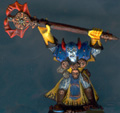Chaos
Servants of Chaos have a number of different "colleges" of magic to choose from. These
are not available to Heroes, unless the GM makes special allowances -- After all, many of
the spells defined for use by monsters really aren't made with Hero usage in mind, and don't
have rules to adequately cover the many possible uses and abuses. (For instance, the
spell "Choke" probably shouldn't be of much use against the Undead.)
 Dark Magic
Dark Magic
Dark Magic is the creation of the Dark Elves, as a twisted counter to the High Magic of
the High Elves. The "Dark Magic" spells listed in Advanced HeroQuest (and used by several
spellcasting monsters) has been incorporated into the expanded
Grey Seer Spell Book. A separate list of spells has
been created for Dark Magic, to incorporate various Dark
Magic spells from Warhammer Fantasy Battles, 4th Edition.
Necromancy
Necromancy is the Dark Art of magically animating and empowering the dead. In the
tradition of the Dark Magic spell deck from Warhammer Fantasy Battles, 4th Edition,
the Necromancy spells from Terror in the Dark have been incorporated into the
expanded Dark Magic Spell Book.
Grey Seer Spells
The Skaven race has its own Chaos Deity, the Horned Rat, and warlocks amongst the
Skaven claim to draw their power from this entity of the Warp. They have their own
brand of magic, as documented in the Grey Seer Spell Book.
 Chaos Sorcerers
Chaos Sorcerers
Chaos Sorcerers invoke their powers from one of the three major Chaos Gods that actually
provide spells for their followers. (Khorne does not condone sorcery, but prefers raw
martial might.) Depending upon their patronage, Chaos Sorcerers may either use the
Nurgle Spell Book, the
Tzeentch Spell Book, or the
Slaanesh Spell Book.
Chaos Beastmen Shamans
Chaos Beastman Shamans may freely choose spells from the spell books
of Nurgle, Tzeentch,
or Slaanesh.
The Waaagh!
Orc and Goblin Shamans cast "spells" drawn from a power known as the "Waaagh!", which is
drawn not from Chaos Gods or the Winds of Magic, but rather from the psychic energies of
the "collective orcishness" of a large horde of Orcs and their kin. As such, Waaagh magic
is dependent upon large gatherings of Orcs -- a lone Orc Shaman cannot conjure up spells,
no matter how fervently he pleads to the two Orc deities of Mork and Gork. Although Mork
and Gork are not actual creatures of the Warp or entities in any meaningful sense,
manifestations of Orc magic typically result in "appearances" by these abstractly formed
deities -- For example, one particularly potent Orc spell involves a giant green foot
descending from the clouds to turn the Orc's enemies into "splutchy pancakes".
Only Orcs and Goblins, incidentally, may be Orc Shamans, and thus be able to make use
of the Waaagh. They use spells from the Waaagh! Spell Book.




